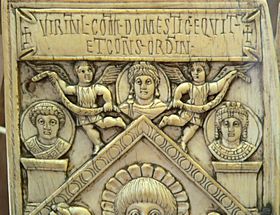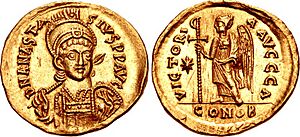Anastasius I Dicorus facts for kids
Quick facts for kids Anastasius I Dicorus |
|
|---|---|

Anastasius I on a consular diptych, AD 517
|
|
| Byzantine emperor | |
| Reign | 11 April 491 – 9 July 518 |
| Predecessor | Zeno |
| Successor | Justin I |
| Born | c. 431 Dyrrhachium (now Durrës) |
| Died | 9 July 518 (aged 87) Constantinople (now Istanbul) |
| Burial | Church of the Holy Apostles |
| Spouse | Ariadne |
| Dynasty | Leonid |
| Religion | Miaphysitism |
Anastasius I Dicorus (Greek: Ἀναστάσιος, translit. Anastásios; c. 431 – 9 July 518) was an Eastern Roman emperor who ruled from 491 to 518. He was a skilled government worker before becoming emperor at 61 years old. He was chosen by the empress Ariadne, the wife of the previous emperor, Zeno.
Anastasius's time as emperor was known for many good changes. He improved the government, how money was handled, and the way the empire was run. He left the empire with a strong government and a lot of gold in its treasury. This helped future emperors, especially Justinian I, to achieve big things. Many of Anastasius's changes lasted for a long time, showing how important he was.
Anastasius was a Miaphysite, which was a Christian belief about Jesus. This caused some disagreements during his rule, as the empire had different religious views. He is considered a saint by the Syriac Orthodox Church.
Contents
Who was Anastasius I?

Anastasius was born in a city called Dyrrachium (now Durrës) around 431 AD. He came from a family in Illyria, an ancient region. He had one black eye and one blue eye, a condition called heterochromia. Because of this, people called him Dicorus, which means "two-eyed." Before he became emperor, Anastasius was very good at managing money for the government.
He had a brother named Paulus, who was an important official. Anastasius also had several nephews and nieces who became important figures in the empire.
How did Anastasius become emperor?
After Emperor Zeno died in 491, many people in the capital city, Constantinople, wanted an emperor who was a traditional Christian and a true Roman. They chanted, "Give the Empire an Orthodox Emperor!"
Under this pressure, Ariadne, Zeno's widow, chose Anastasius to be the new emperor. He was in his sixties at the time. Ariadne chose him instead of Zeno's brother, Longinus, which made Longinus's supporters, the Isaurians, upset. It also upset the "Blues" and "Greens," who were like powerful sports teams and political groups. These groups often caused riots.
Anastasius had different religious beliefs (he was a Miaphysite). So, before he became emperor, the leader of the church in Constantinople made him promise not to reject an important church decision called the Council of Chalcedon.
Ariadne married Anastasius shortly after he became emperor in April 491. He quickly became popular by lowering taxes, especially a disliked tax that mostly affected poor people. He worked hard to manage the empire's affairs. His changes helped the empire collect more taxes and recover from financial problems. By the end of his rule, the empire had a huge amount of gold saved up.
What wars did Anastasius fight?
Anastasius's empire fought two main wars: the Isaurian War and the Anastasian War.
The Isaurian War (492–497)
This war started because Longinus, Zeno's brother, wanted to be emperor instead of Anastasius. Longinus's supporters, the Isaurians, started a rebellion. A big battle in 492 weakened the rebels, but fighting continued in the mountains for several years. The war lasted five years, but Anastasius still managed to make economic changes during this time. After the war, many Isaurians were moved to a different part of the empire to prevent future rebellions.
The Anastasian War (502–505)
This war was against the Sassanid Persians. The Persians captured two important cities, but the Romans later got one back by paying gold. Both sides suffered a lot. A peace treaty was signed in 506. After the war, Anastasius built a strong fortress called Daras to protect the border from the Persians.
He also built the Anastasian Wall to protect Constantinople from invasions by the Slavs and Bulgars, who were attacking the Balkan provinces. He also made his home city, Dyrrachium, a very strong fortress on the Adriatic Sea.
How did Anastasius rule the empire?
Anastasius was a Miaphysite, but he tried to keep peace in the church. However, in 512, after his success against the Persians, he replaced the church leader in Chalcedon with a Miaphysite. This broke his promise and caused riots.
The next year, a general named Vitalian started a rebellion. He defeated an imperial army and marched towards Constantinople. Anastasius tried to make peace with Vitalian and even talked to the Pope. Two years later, another general, Marinus, defeated Vitalian. After this, Anastasius had full control of the empire until he died in 518.
Who became emperor after Anastasius?
There's a story that Anastasius tried to figure out which of his nephews would be the next emperor. He put a secret message under one of three couches. He thought the nephew who sat on that couch would be his heir. But two nephews sat on one couch, and the couch with the message stayed empty! After praying, he decided the first person to enter his room the next morning would be the next emperor. That person turned out to be Justin I, the chief of his guards.
Anastasius died in Constantinople on July 9, 518. He was around 87 or 88 years old. He left the empire with a huge amount of gold in its treasury – about 320,000 pounds of gold! After him, Justin I, who was a peasant and couldn't read, became emperor. Meanwhile, Justin's nephew, Justinian I, who would become a very famous emperor, was already becoming important in Constantinople.
What changes did Anastasius make to the government and money?
Anastasius was very interested in making the government work better and improving the economy. He changed how payments were made, from goods to actual money. This made it harder for people to steal and easier to keep track of finances. He also made people pay taxes with cash instead of goods.
He stopped giving soldiers their uniforms and weapons. Instead, he gave them money to buy their own. These changes worked well. Taxpayers often paid less, but the government still collected more money. This extra money allowed the emperor to pay soldiers higher wages, which encouraged Roman citizens to join the army instead of relying on foreign soldiers. Anastasius is often praised for his "careful management" of the empire's money.
However, Anastasius also continued the practice of selling government jobs. He sold so many that some historians say he helped create a group of powerful civilian families. He also gave important jobs to his friends and family members.
Anastasius also fixed the empire's money system in 498. He created new gold coins (the solidus) and copper coins (the follis). These new coins quickly became important for trade. Coins from Anastasius's reign have been found far away, even in China, showing how widely they were used. The money system he created lasted for a long time after his rule.
A coin from Anastasius is even shown on the 50 denar banknote of North Macedonia today.
See also
 In Spanish: Anastasio I (emperador) para niños
In Spanish: Anastasio I (emperador) para niños
Images for kids
-
The Barberini ivory, a 6th-century ivory carving that might show Anastasius or Justinian I.







